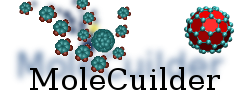| Version 2 (modified by , 11 years ago) ( diff ) |
|---|
Fitting a water potential
In this example we will use a brief molecular dynamics simulation of a single water molecule to fit a (in MoleCuilder terminology) compound potential, consisting of constant, Morse, and angle potentials.
Molecular dynamics simulation of water
First of all, we need to perform a molecular dynamics simulation of water.
Below you found the necessary command to perform such an MD simulation:
./molecuilder \
--input water.pdb \
--select-all-atoms \
--molecular-dynamics \
--steps 100 \
--keep-bondgraph 1 \
--output-every-step 1 \
--deltat 0.1 \
--order 1 \
--DoLongrange 0 \
--fragment-resultfile BondFragmentResults.dat \
--save-homologies homologies.dat
The command consists of loading the file water.pdb (see attached files), selecting all atoms for the dynamics simulation and performing it. There, we use 100 steps, keep the bond graph (in case the initial configuration is not equilibrated and oscillations are too strong) and do not include long range forces. Furthermore, a bond order of 1 is sufficient and a small time steps (deltat) ensures proper time integration of the dynamics.
Note especially the last command that stores the so-called homologies in a separate file. Homologies are the set of all equivalent configurations and fragments, i.e. when performing a simulation with many water molecules, then each water molecule is homologous (having the same structure, the same chemical formula) to any other water molecule. Hence, each molecule is stored under the same formula, namely H2O, in an internal container of MoleCuilder, including the resulting ab-initio energy and all interatomic distances. At the end of the dynamics simulation, many different configurations of a single water molecules are gathered under this key H2O. And each of them will have a slightly different energy; for example because the hydrogen atoms are slightly further away from the oxygen. In essence, we have many snapshots (with energies) of the oscillating water molecule.
This homology file homologies.dat serves then as the data set to the subsequent potential fitting.
Attachments (2)
-
water.pdb
(561 bytes
) - added by 11 years ago.
PDB file of a water molecule
-
water.potentials
(369 bytes
) - added by 11 years ago.
.potentials file for a compound potential for water
Download all attachments as: .zip
